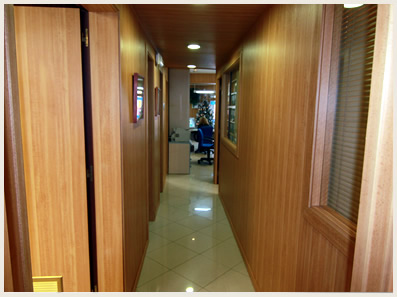|
Sumário
• With the heating
• In hot water
• With the electricity bill
• With Lighting
• With the lifts
• The distribution of spending in the Community of Neighbors
• Saving water in the residents'
With heating
• Proper maintenance of the facility is a determining factor in achieving savings and efficiency. Note that for security, maintenance, professional technicians should always perform it.
• Current legislation (Regulation of Technical Installations-RITE) requires that individual facilities have a collective thermostat and the central boiler with a system of regulation. PBX systems with regulation achieved significant savings with respect to facilities that do not.
• Remember that the sum of good maintenance and a good system of regulation allows, common services, total energy savings of over 20%.
• It is not uncommon for residents of upper floors fail to warm up their homes, while the inhabitants of the lower floors suffer from excessive heat. These differences are due to an imbalance of the network hydraulic piping hot water. Relax in the hands of professional technicians that will fix the problem.
• Although it is rare that the portal area, corridors and hallways are heated, I recommend installing a double door on the porch and closing mechanisms of automatic doors to the outside, so avoid them stay open involuntarily.
• The windows of the stairs should not be left open longer than the time required by the ventilation of adjacent areas.
• At night, except in very cold places, you should turn off the heating until the next morning.
• When choosing the boiler is important to know that the boilers with 4 stars are those with better performance.
• Condensing boilers and low temperature, despite being more expensive than conventional (up to twice the price) may seek energy savings over 25%, so the extra cost can be recovered over a period of 5 to 8 years, ie in less than half the life of such equipment.
• In the case of boiler plants with a silo for fuel storage and access for loading and unloading the same, a very interesting option to consider is to replace the boiler for other biomass, or adapting the old coal boiler by installing biomass burners.
• Over 10% of the total energy can be lost through the distribution pipes, if not properly isolated. To avoid these losses is important to insulate any pipes that run through unheated spaces (boiler room, garages, ceilings, small courtyard, etc.)..
• Remember that heating with hot water may represent more than 60% of the cost of a residents.
With hot water
Good maintenance is essential for the proper functioning of these facilities, thereby avoiding the waste of energy. The central hot water services are complex plants whose maintenance must be carried out by professional technicians.
• It is very important to avoid heat loss through hot water pipes, for which they need to be properly insulated and the consumption points are as close as possible to the boiler.
• It is advisable to also install a timer function to prevent the recirculation of hot water at night and thereby achieving a negligible savings in utility costs.
• Systems for the production of instant hot water requires continuous starts and stops of the boiler which carry a higher energy cost than systems with accumulation.
• In systems with accumulation, because the power required for hot water preparation are generally well below those needed for heating, it is advisable to use separate boilers for the production of each.
• When the boiler is of a kind or low temperature condensation, whose income does not decrease when not operating at full load, you might consider installing a single boiler for heating and hot water production. In addition, the boiler output may be less than the sum of the heating plus hot water production, as it is very unlikely to meet demand both services simultaneously at maximum power.
• Solar thermal energy is a very interesting option for producing hot water. These facilities are generally dimensioned to provide housing for between 50% and 70% of hot water demand and investment required can be amortized in less than half the lifetime of the equipment.
With the electric bill
• In some communities owned more than one power supply. In these cases, you unify supplies to achieve significant financial savings.
• It should also review a specialist electrical contracting: it is possible that the contracted power is greater than necessary or that the agreed price is not the most appropriate. In many cases, charges that reclaiming consumption in peak hours at night and are cheaper.
• For hourly rates with discrimination, it is important to study the electric bill and see if the company is penalizing the residents for not having compensated reactive power. Charges for this concept can reach 47% and yet, with adequate compensation of power factor, you can get bonuses of up to 4%.
With illumination
• The sectorization, timing systems and detectors of presence, coupled with the use of energy-saving lamps and fluorescent tubes can reduce over 75% spending on lighting.
• In areas of transit, such as portals, stairs or hallways is convenient to use timing systems, so that lights are switched off after a preset period.
• A good idea is to sectorize switches the lights of stairs, hallways, garages and common areas to prevent ignition at a time, and promote the installation of sensors to which they really light up when needed.
• The choice of lighting is also very important: the better to reflect and distribute the light, the less power will be installed. The mirror type aluminum are the best performance, although not to lose effectiveness need periodic cleaning.
• Remember to replace incandescent lamps with low-energy and / or fluorescent tubes will save on the electricity bill.
• Induction lamps, depending on whether they are standard or compact, can have a useful life that varies from 40,000 to 100,000 hours. These systems are therefore ideal for interior and public lighting in residential areas in places of difficult access for replacement.
• In gardens, patios and other areas in the open, avoid leaving lights on installing a clock on / off programmer or systems using photoelectric cell, which switch off the lights when the ambient light exceeds a certain level.
• For gardens, there are lights and lantern balloons that minimize light pollution by directing the flow of light toward the ground, without a "leak" light into the sky. Keep this in mind.
• After a certain time of night should lower light levels in areas with little traffic or off lights, keeping those that are considered essential.
• At all times, it is important to illuminate only the spaces that require it and not emit light into unwanted areas: in addition to saving energy by avoiding troublesome glare.
With the lifts
• If your community has more of a lift, do not call them simultaneously and never consider walking down the stairs (or even raise them, if they are not too many flats): a healthy habit and save energy.
• In any case, intends to install a separate operating mechanism to reduce travel in vacuum lifts. You'll save electricity and prolong the life of them.
• It is interesting that the inside of the elevator is not permanently illuminated. Propose the presence detector installation to activate the light on only when someone enters the lift.
The distribution of spending in the Community of Neighbors
• With the entry into force of Regulation of Thermal Installations in Buildings (RITE), community facilities and hot water heating, built after August 1998 must carry a heat meter for each user individually, so that each neighbor pay only what they consume.
• If your home is before 1998, to promote the installation of individual meters for heating and water consumption: the distribution of expenditure achieved on the basis of actual consumption and save between 20% and 30%.
• Good maintenance of heating equipment and centralized hot water could represent savings of up to 20%.
Saving water in the residents'
• If your community offers green areas, offer native vegetation is planted or that requires little watering.
• Promote systems of type drip irrigation and rainwater use previously accumulated for that purpose.
• If your neighborhood community has heated pool or its installation, is required to use only use solar systems to heat water. The use of thermal blankets to cover the pool at night is another idea to save energy.
• In the pool, install a program that is preventing the plant is running longer than necessary.
 top top
|
|








